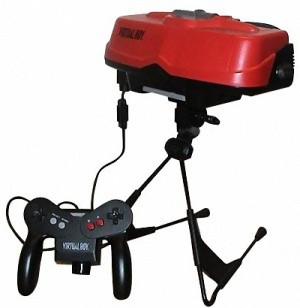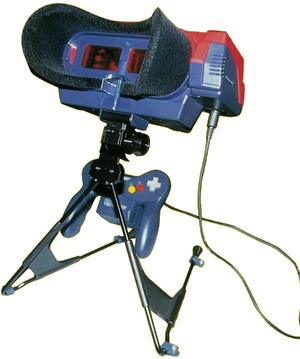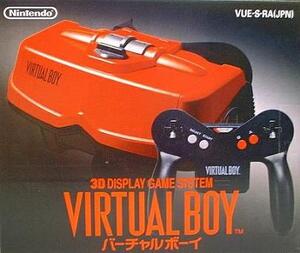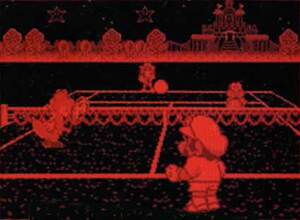
‘Failure’ is not a word you’d usually associate with Nintendo. Sure, there have been some crushing disappointments in the company’s illustrious history – the N64 and GameCube spring to mind – but even those two machines have played host to some of the best videogames ever seen, so they can hardly be classed as complete flops. Nintendo has an impeccable track record of making great hardware and even greater games, but there is one serious blot on this otherwise immaculate reputation – the much-maligned Virtual Boy.
Back in the early 90’s Nintendo were simply unstoppable, with the SNES and Gameboy dominating the global market. The creator of the Gameboy, Gunpei Yokoi, began work on another machine which was rumoured to take advantage of new-fangled ‘VR’ technology. Anticipation in this mystery console was increased as industry experts confidently heralded ‘immersive gaming’ as the next big thing. Development on the project was slow, and as the 16-bit era drew to a sluggish and painful close, the top brass at Nintendo of Japan started to get impatient with Yokoi’s leisurely progress and demanded that he bring his project to a satisfactory conclusion. Yokoi reluctantly did so (which would have serious ramifications later, as we will see) and the resulting ‘Virtual Boy’ was trust into the spotlight.


The actual technology inside the Virtual Boy was a triumph of low-cost electronics. Early in development it was decided that having a full size display inside would make it too bulky and drive the price up to unacceptable levels, so the designers lumped for rapidly moving mirrors to fake the impression of a single display. The Virtual Boy displayed a monochrome image, just as the Gameboy did before it. However, the primary colour was red because red LEDs consumed the least amount of power.
Although the unit could be powered off normal batteries as well as the mains, it was a far cry from the portable device Nintendo initially tried to market it as and this is possibly one of the main reasons why it failed so spectacularly. Nintendo insinuated that it was the next stage in the evolution of the Gameboy, but it should be noted that creator Yokoi never intended it to be so. The unit was also highly susceptible to internal damage when moved around and the flimsy stand didn’t take much in the way of punishment. On the whole the console didn’t radiate the usual impression of solid, dependable Nintendo build quality. Although it was not intended as a direct competitor to the home consoles of the time, the high launch price and aforementioned lack of mobility meant it was perceived as such by the general public.

The unit itself resembled a VR headset in many ways, but did not secure to the player’s head. Instead, it sat on a flat surface (such as a table) and the player had to lean down to look into the device. Unsurprisingly, back and neck pain proved to be a common, but particularly unwelcome, side effect.
Software was limited and of generally average quality. Most of the 22 games released in the US and Japan were produced by Nintendo themselves, but aside from Mario and Wario, no other key franchises graced the machine. Third party support was pitifully weak, and rumours circulated that Nintendo had deliberately kept many external developers away from the machine to ensure there wasn’t a flood of poor quality software.
The Virtual Boy had the misfortune of being released just as the 32-bit Sony Playstation and Sega Saturn were hitting stores worldwide, and with such an expensive price point it really didn’t stand a chance, regardless of the strong Nintendo brand. Scare stories about the display causing everything from headaches to permanent eye damage probably didn’t help matters either, and the console slid into a rapid decline that resulted in Nintendo discontinuing production just a year after release. A US launch came and went with little success, but Europe – so often an afterthought in Nintendo’s plans – was ignored.

When the dust finally settled it was clear that Nintendo needed a scapegoat, and that was Yokoi. The man who had given the corporation one of its most endearing successes in the form of the Gameboy was blamed almost entirely for the failure of the machine. The fact that he had argued against releasing it too early was conveniently forgotten. Driven from the company he had helped make millions for, the legendary designer later assisted Bandai with the creation of the their much-respected Wonderswan – ironically one of the first handhelds to really give the aging Gameboy a run for its money. Tragically, Yokoi was killed in 1997 when he stepped out of his car to investigate a traffic accident in which he had just been involved – he was sideswiped by another car.
Although they quickly tried to forget the machine, Nintendo have relaxed their stance on the Virtual Boy recently. It’s now accepted as part of the company’s colourful history and has even been granted cameos in several recent games, most notably the best selling Warioware series. It still ranks as Nintendo’s only ‘true’ failure, but you can’t help wondering what it could have been like had Yokoi been giving the support and time he so badly craved.





Comments 6
You know, I never actually knew much on the Virtual Boy until now. I am surprised that Nintendo let something like that pass into manufacture... especially against a machine like the PSX!
I would still love to try one out at some point in time, regardless of how bad it is.
I've got a Virtual Boy and three games (Red Alarm, Virtual League Baseball and Mario's Tennis) and to be honest, I don't think it's THAT bad, I just wish it had more decent games and didn't display everything in red!
The most awesome machine ever made. Dramatically under-rated IMHO
True 3D graphics and even 3D sound!!
When playing Mario Tennis you can hear the ball bounce past you.
As for peoples moans about headaches....had one for years played a lot and never a head-ache
For real VB details
www.virtual-boy.org
Keeping it alive!!!
@Nanaki
You mean the PS1 the PSX was a Japanese release only ps2 &pvr combo.
for all of you guys that never had the chance, is Nintendo games! if that means something to you. the games are well done, and even at that time i remember not been amazed by the power or graphics. i always questioned the 32bit thing. anyways, i also think is not that terrible.
They should release Virtual Boy games on the 3DS eShop.
Show Comments
Leave A Comment
Hold on there, you need to login to post a comment...